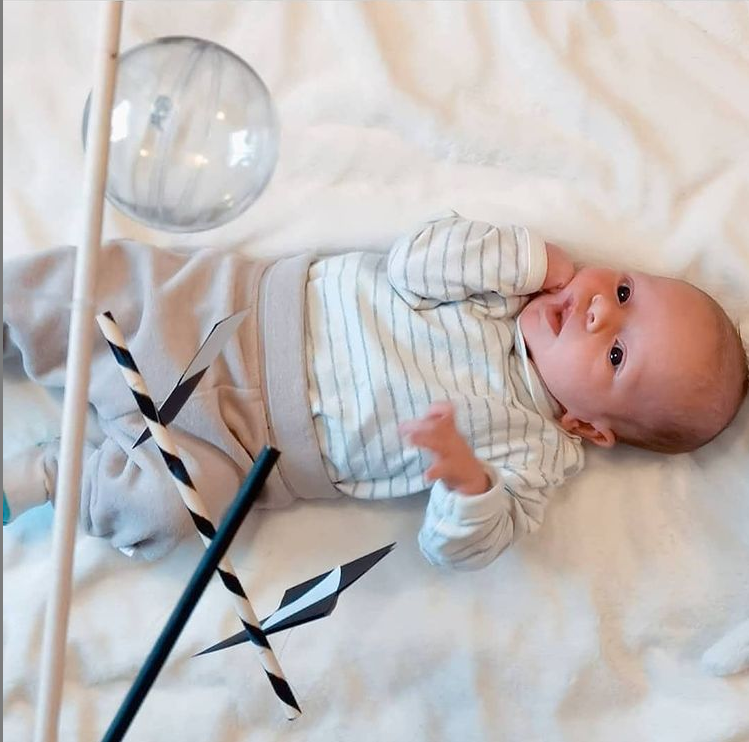There are so many Montessori misconceptions out there that seem to get stuck in people’s mind! We believe that all we need to do is grab a few wooden sticks, make a baby gym out of them, hang a Montessori baby mobile off it and – TA DA! – our baby will be happily lying under there for hours, happily giggling away, their development happening right in front of our eyes! All you have to do is to change the mobiles in every two weeks, following the given sequence. Well, while there is a strong base for each of these claims, we do need to be realistic. Let’s get started with the Montessori myth busting!
1. Expecting your few weeks old baby to concentrate on their Montessori mobile for an extended period of time
This is probably the fact that surprises most people. While there ARE babies who are so taken with their mobiles that they remain almost motionless for almost 10 minutes at a time, this is not that common.
Newborn babies first have to figure out how to move their two eyes in unison, learn how to focus and how to make them move independently from the movements of the head. These are really hard to achieve! That’s why they can actually focus for only short bursts at a time. Their concentration span will grow together with their visual skills.

2. Thinking your baby will go through every single Montessori mobile in the sequence
Every baby develops at a different pace and in a different way. They also learn many skills outside of their time with their Montessori mobiles. They might improve their vision outside while watching the leaves dancing in the breeze, or through other activities you provide for them (check out this post about black and white baby resources at home.)
This can result in the fact that by the time they get to the baby mobile suggested for their age, they might not be interested as they already possess those particular skills. This is absolutely normal. And this is one of the reasons why I suggest making your baby mobiles all DIY, instead of buying them ready-made and doing these first BEFORE you invest in any Montessori material.
This leads us to….
3. Buying all the Montessori materials ready-made
If you have the space and the means to do so, go for it! However, it is not necessary. We all know how expensive it is to prepare everything for a baby, Montessori materials really shouldn’t add to this expense!
Why not give it a go and make them yourself? I promise you, having ready-made materials or DIY ones will not make ANY difference in your baby’s development. And if it’s not perfect? Don’t worry, your 2-month-old baby will not complain!

If you’re still in doubt, read my post about whether you should buy or DIY Montessori baby material.
4. Changing the Montessori mobiles according to the suggested time frames
This is huge and the reason why I started to write about Montessori myth busting. As I mentioned in the previous point, all babies develop in their own way. This means that while your baby might happily observe their Montessori Munari mobile for 3 or 4 weeks, they might spend only a week or two with the Octahedron and skip the Gobbi altogether. Again, this is absolutely fine.
How do you know when to change the mobiles? Always observe your baby and their reactions (here’s a blog about what kind of baby reactions to expect). When you notice that your little one is not interested in the mobile, it’s time to change. But if they still spend a good 10-15 minutes babbling to it, then there’s no reason to change it. As Maria Montessori always said, “follow the child”.
5. Expecting your baby to enjoy observing their Montessori mobile all day long
Babies are like adults in a sense that they have likes and dislikes, good days and bad days. Sometimes they are more inclined to focus on learning and developing, other times they just want to snuggle up with you after a bad night.
A good rule of thumb to follow here is to make sure that when you lie your baby under the baby gym, they are clean, well-rested, well-fed, alert and in a good mood. If these conditions are met, there’s a very good chance that you will be hearing some cute baby noises coming from the Montessori movement area (read this blog to learn how to set one up).
6. Waiting for your baby to play independently
While most of the Montessori materials indirectly aid independent play and you are encouraged not to interfere with your baby’s ‘work’, we cannot leave them alone.
Montessori mobiles are exceptional in helping your baby’s development. As they grow, they also learn to concentrate longer and with more focus, amongst other things. But even more important to them is to spend time with YOU. Babies are babies, who crave your closeness, love to snuggle, and want to feel safe, protected and loved. No Montessori material can give them this.
FINAL THOUGHTS
I fully believe that the best things you can give to your baby to ensure their smooth and continuous development are Montessori baby materials. However, we have to be clear about our expectations towards the materials and towards our tiny human, too. I hope that this post about Montessori myth busting helped you to adjust these to a more realistic level.
Do you know any other myths that need busting?
Click here to read more about how the Montessori Visual Mobiles, the Montessori Tactile Mobiles or the Sensory Baby Toys help your baby’s development.
Does your baby like Montessori toys? Share it with us in the comments section or tag me in your Instagram photos. #montessoriedited, @montessoriedited
